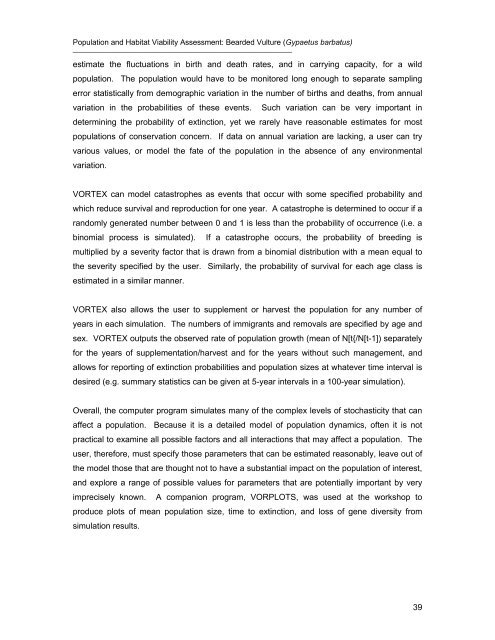BEARDED VULTURE POPULATION AND HABITAT VIABILITY ...
BEARDED VULTURE POPULATION AND HABITAT VIABILITY ...
BEARDED VULTURE POPULATION AND HABITAT VIABILITY ...
You also want an ePaper? Increase the reach of your titles
YUMPU automatically turns print PDFs into web optimized ePapers that Google loves.
Population and Habitat Viability Assessment: Bearded Vulture (Gypaetus barbatus)<br />
________________________________________________<br />
estimate the fluctuations in birth and death rates, and in carrying capacity, for a wild<br />
population. The population would have to be monitored long enough to separate sampling<br />
error statistically from demographic variation in the number of births and deaths, from annual<br />
variation in the probabilities of these events. Such variation can be very important in<br />
determining the probability of extinction, yet we rarely have reasonable estimates for most<br />
populations of conservation concern. If data on annual variation are lacking, a user can try<br />
various values, or model the fate of the population in the absence of any environmental<br />
variation.<br />
VORTEX can model catastrophes as events that occur with some specified probability and<br />
which reduce survival and reproduction for one year. A catastrophe is determined to occur if a<br />
randomly generated number between 0 and 1 is less than the probability of occurrence (i.e. a<br />
binomial process is simulated). If a catastrophe occurs, the probability of breeding is<br />
multiplied by a severity factor that is drawn from a binomial distribution with a mean equal to<br />
the severity specified by the user. Similarly, the probability of survival for each age class is<br />
estimated in a similar manner.<br />
VORTEX also allows the user to supplement or harvest the population for any number of<br />
years in each simulation. The numbers of immigrants and removals are specified by age and<br />
sex. VORTEX outputs the observed rate of population growth (mean of N[t{/N[t-1]) separately<br />
for the years of supplementation/harvest and for the years without such management, and<br />
allows for reporting of extinction probabilities and population sizes at whatever time interval is<br />
desired (e.g. summary statistics can be given at 5-year intervals in a 100-year simulation).<br />
Overall, the computer program simulates many of the complex levels of stochasticity that can<br />
affect a population. Because it is a detailed model of population dynamics, often it is not<br />
practical to examine all possible factors and all interactions that may affect a population. The<br />
user, therefore, must specify those parameters that can be estimated reasonably, leave out of<br />
the model those that are thought not to have a substantial impact on the population of interest,<br />
and explore a range of possible values for parameters that are potentially important by very<br />
imprecisely known. A companion program, VORPLOTS, was used at the workshop to<br />
produce plots of mean population size, time to extinction, and loss of gene diversity from<br />
simulation results.<br />
39


